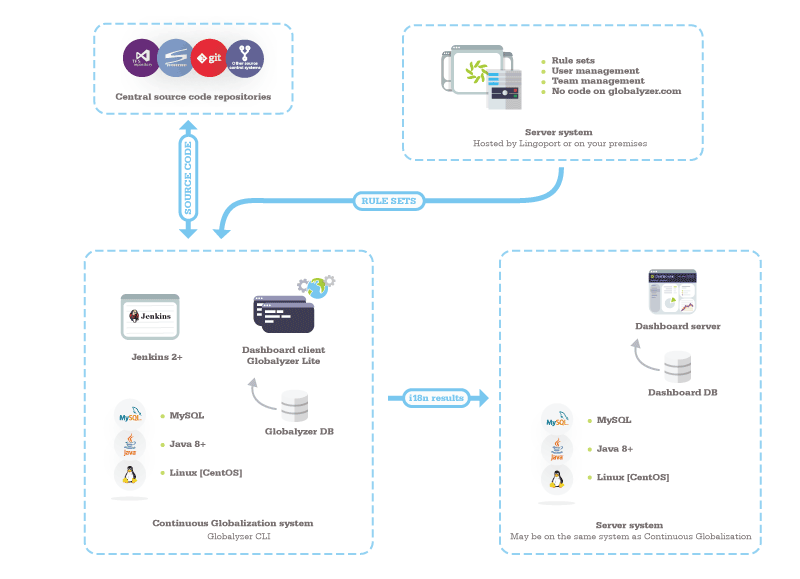Difference between revisions of "Globalyzer CLI for Continuous Globalization"
(→Installation Components) |
(→Installation Components) |
||
| Line 26: | Line 26: | ||
= Installation Components = |
= Installation Components = |
||
| − | * The '''Globalyzer Server''' is hosted by Lingoport. If the Globalyzer Server is on site, a Linux machine is needed to be installed with Globalyzer Server. |
+ | * The '''Globalyzer Server''' (System server) is hosted by Lingoport. If the Globalyzer Server is on site, a Linux machine is needed to be installed with Globalyzer Server. |
| − | * The '''Dashboard Server''' and '''Build Server''' is shown on different machines, although they could be one machine. The Globalyzer CLI client is installed on the Build Server to analyze code. |
+ | * The '''Dashboard Server''' and '''Build Server''' (Continuous Globalization system) is shown on different machines, although they could be one machine. The Globalyzer CLI client is installed on the Build Server to analyze code. |
* The '''Developer Machine''' is not shown in this diagram. The developer will push source code to the repositories and may not have any Lingoport Software on their machine. |
* The '''Developer Machine''' is not shown in this diagram. The developer will push source code to the repositories and may not have any Lingoport Software on their machine. |
||
Revision as of 21:23, 29 December 2016
Contents
Introduction
Globalyzer CLI can be deployed on a Continuous Globalization system. It enables i18n scanning of a project based on a Globalyzer project.gproj saved filed most likely at the top level directory of the source code; the results are then pushed to the Dashboard.
Target User
The results are presented via the Dashboard for any registered users, such as development team members, development management, i18n specialists, L10n management, translators, QA, etc.
The typical Globalyzer CLI actoris a Jenkins system which automates the tasks of scanning and pushing the results to the Dashboard.
Typical Deployment
The Globalyzer client, including the Command Line Interface jar file, has been installed on the Continuous Globalization system, with a database to store the results of the scans.
The source code may have a project.gproj file at the top level directory which specifies how the code should be scanned.
Note: If you add LRM to this picture, the Continuous Globalization system needs to be a Linux machine, preferably CentOS.
Typical Workflow
Jenkins uses the Globalyzer CLI via scripts to:
- Get the code to be analyzed from a repository
- Optionally, import the Globalyzer project from the
project.gprojfile if necessary; The project may already exist in the database.
- Optionally, import the Globalyzer project from the
- Scan the code for potential i18n issues
- Push the results of the scan to the Dashboard
This requires the rule sets used to scan the code have been vetted and the Globalyzer project.gproj file makes sense.
Installation Components
- The Globalyzer Server (System server) is hosted by Lingoport. If the Globalyzer Server is on site, a Linux machine is needed to be installed with Globalyzer Server.
- The Dashboard Server and Build Server (Continuous Globalization system) is shown on different machines, although they could be one machine. The Globalyzer CLI client is installed on the Build Server to analyze code.
- The Developer Machine is not shown in this diagram. The developer will push source code to the repositories and may not have any Lingoport Software on their machine.
Installation Notes
To install the Command Line Interface client (CLI), login to the Globalyzer server, download the Globalyzer Client installer for the platform you are running on, and run the installer.
